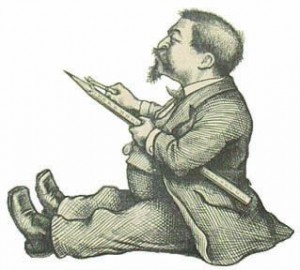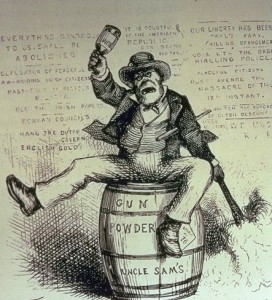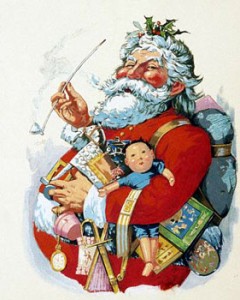Whenever visions of Santa Claus dance in our heads, the image we often conjure up is the cheery, red-cheeked elf drawn by 19th-century cartoonist Thomas Nast.
Acclaimed as the father of all political cartoonists, Nast drew for Harper’s Weekly in the mid- to late-1800s. His drawings of St. Nick are undeniably iconic. (The Republican elephant and the Democratic donkey? Those were his too.)
So, you might ask, how could the artist who brought Father Christmas to life have so many Irish-Americans in such an uproar?
Simply this: Nast’s cartoon characterizations of the Irish in general, and Irish Catholics in particular, are construed by many Irish as deeply offensive. In Nast’s illustrations, the Irish were depicted as drunken, violent hooligans who resembled monkeys … and Roman Catholic cardinals were snapping alligators threatening the American way of life. This year, Nast’s illustrations are no longer simply a matter for the history books. Nast, who lived in Morristown, N.J., is among the nominees for the 2012 New Jersey Hall of Fame—and that has New Jersey politicians, including Gov. Chris Christie, and organizations such as the New Jersey Ancient Order of Hibernians, questioning his inclusion.
Locally, Philadelphia’s Irish Anti-Defamation Federation (IADF) is orchestrating a letter-writing campaign which the group hopes will lead the Hall of Fame to drop Nast from consideration. The group met Thursday night at the Philadelphia Irish Center to map out strategy.
Recently, IADF Chairman Tim Wilson sent a letter of protest to Hall of Fame Executive Director Don Jay Smith, in which Wilson suggested the Hall of Fame board of commissioners failed to appreciate Nast’s “deplorable history.”
“Thomas Nast is infamous in American history as one who portrayed Irish immigrants and Irish-Americans as violent apes and drunks. Nast, both in his verbal rhetoric and in his drawings, was openly prejudiced against the Irish people, and Roman Catholics from all groups of citizens in America,” Wilson wrote. “Thomas Nast’s paid ‘work’ has been cited by social historians as instigating the Nativist riots in America, wherein Roman Catholic churches were burned to the ground, and Irish neighborhoods laid waste.”
Wilson demanded that Nast be removed from this year’s ballot (you can see it here) and from all future consideration, and he requested a public apology.
In an interview before the meeting, Wilson said, “They (the Hall of Fame) argue that he is famous, that he’s a part of history. They think we should overlook his bigotry because of Santa Claus, the elephant and the donkey.”
They should think again, Wilson said.”We’ve put up with the stereotyping. Now people are just getting tired of it.”
Wilson noted that the New Jersey Ancient Order of Hibernians is a member of the Hall of Fame voting committee, which reviews nominees and pares them down to a field of 50, divided into five categories. In this case, Wilson said, the Ancient Order of Hibernians “were never contacted.”
In an interview Friday, Executive Director Smith said all members of the Hall of Fame Voting Committee were contacted. At the time, the committee included the former president of the state AOH. “No one ever said anything about Nast not being wanted or not worthy.”
The Hall of Fame board of commissioners includes many Irish-Americans, Smith added, and not one has raised an objection. Furthermore, Smith observed that Nast has been nominated three times, but no one has questioned his presence on the ballot … until now.
The decision now rests with the public, which votes for the nominees online.
Smith said no one associated with the Hall of Fame intended to “upset or offend anyone.” He went on to suggest that Nast’s cartoons need to be considered in the light of history. Nast’s ultimate target was the notorious “Boss” Tweed and New York City’s Tammany Hall Machine. Irish immigrants were regarded as key supporters of that infamously corrupt regime.
“People should consider these flaws in the context of the time,” Smith said. “Political cartoonists are the attack dogs of journalism. They always stir people up more than the written word.”
Moreover, Smith said, Nast’s Irish cartoons make up a small percentage of his work, and his characterizations of the Irish lasted only as long as the Tammany Hall Machine remained in power.
Voting for the Hall of Fame continues through January 1. The 2012 inductees will be announced later that month.



